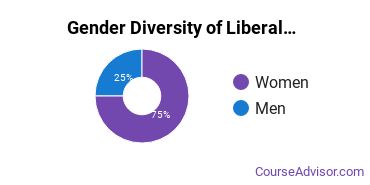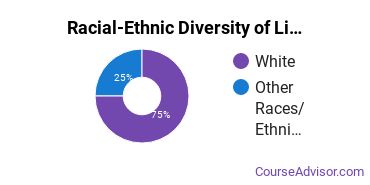Liberal Arts General Studies at William Woods University
William Woods is located in Fulton, Missouri and approximately 2,114 students attend the school each year.
Want to know more about the career opportunities in this field? Check out the Careers in Liberal Arts General Studies section at the bottom of this page.
William Woods Liberal Arts General Studies Degrees Available
- Associate’s Degree in Liberal Arts
William Woods Liberal Arts General Studies Rankings
Find William Woods University Programs
Maximize your transfer credits and complete your bachelor's degree faster with this flexible online bachelor's from Southern New Hampshire University.
Liberal Arts Student Demographics at William Woods
Take a look at the following statistics related to the make-up of the liberal arts majors at William Woods University.
William Woods Liberal Arts General Studies Associate’s Program

The majority of those who receive an associate's degree in liberal arts at William Woods are white. Around 100% fell into this category, which is below average for this degree.
The following table and chart show the race/ethnicity for students who recently graduated from William Woods University with a associate's in liberal arts.

| Race/Ethnicity | Number of Students |
|---|---|
| Asian | 0 |
| Black or African American | 0 |
| Hispanic or Latino | 0 |
| White | 3 |
| International Students | 0 |
| Other Races/Ethnicities | 0 |
Concentrations Within Liberal Arts General Studies
If you plan to be a liberal arts major, you may want to focus your studies on one of the following concentrations. The completion numbers here include all graduates who receive any type of degree in this field from William Woods University. Some of these focus areas may not be available for your degree level.
| Concentration | Annual Degrees Awarded |
|---|---|
| Liberal Arts | 4 |
Careers That Liberal Arts Grads May Go Into
A degree in liberal arts can lead to the following careers. Since job numbers and average salaries can vary by geographic location, we have only included the numbers for MO, the home state for William Woods University.
| Occupation | Jobs in MO | Average Salary in MO |
|---|
References
*The racial-ethnic minorities count is calculated by taking the total number of students and subtracting white students, international students, and students whose race/ethnicity was unknown. This number is then divided by the total number of students at the school to obtain the racial-ethnic minorities percentage.
- College Factual
- National Center for Education Statistics
- O*NET Online
- Image Credit: By AgnosticPreachersKid under License
More about our data sources and methodologies.

